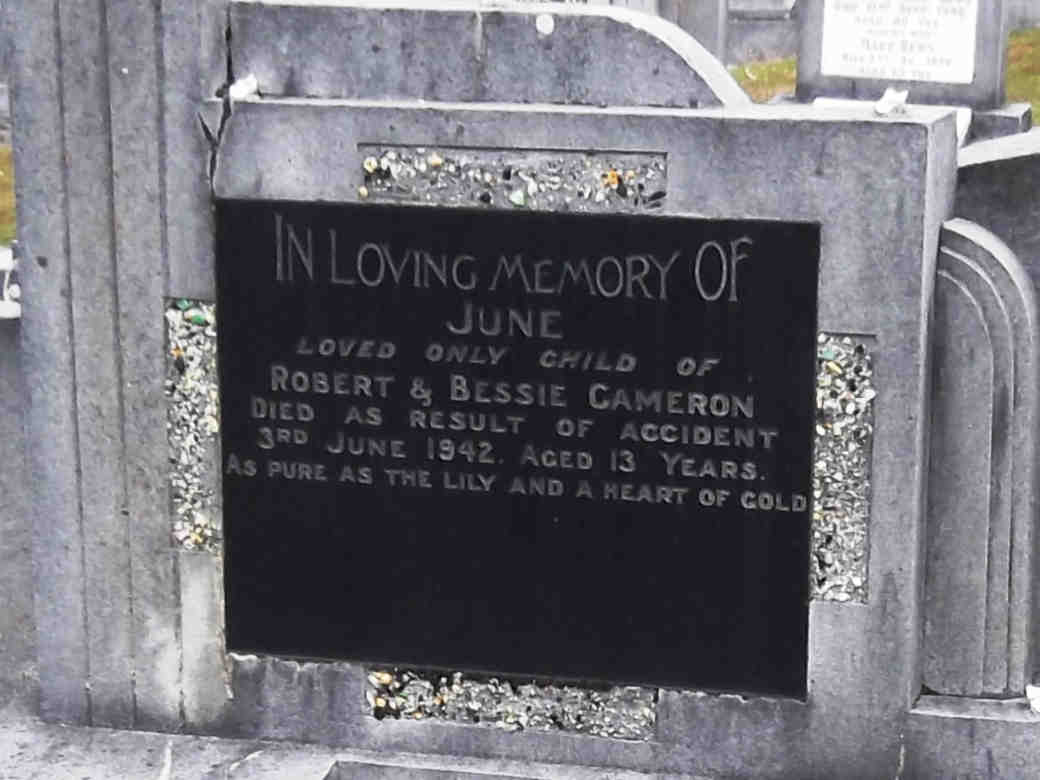OUT OF CONTROL
ROSLYN CABLE TRAM
YOUNG GIRL INJURED
Passengers on the 4.30 p.m. cable tram from Rattray street to Kaikorai yesterday had an alarming experience when the car became partially out of control on the steep grade leading down to the Kaikorai Valley terminus. As the tram gained momentum on the grade a girl of 13 apparently jumped from the car and received injuries which necessitated her removal to the Hospital. There were six or seven passengers on the tram at the time.
The manager of the City Corporation Transport, Mr W. H. Mackenzie, said last night that, although the car hit the turntable at the end of the line with considerable force, the indications were that it had been brought at least partly under control again. Nothing more could be said, however, until full inquiries had been made.
The girl who was admitted to Hospital was June Cameron, whose home is in Manchester street, Roslyn. She is suffering from concussion, cuts on the head, and abrasions. -Otago Daily Times, 2/6/1942.
ROSLYN TRAM MISHAP
DEATH OF GIRL INVOLVED
June Cameron, aged 13, who was injured when the Roslyn cable tram got out of control on Monday afternoon, died in the Public Hospital this morning. An inquest was opened this afternoon before Mr H. W. Bundle. S.M., and after evidence of identification had been given was adjourned sine die. -Evening Star, 3/6/1942.
DEATHS
CAMERON. — On June 3, 1942, at Dunedin (result of accident), June Helen Ann, dearly beloved only daughter of Robert and Bessie Cameron, 25 Manchester street. Kaikorai Valley; aged 13 years and 2 months. “So loved, so mourned.” — The Funeral will leave her parents’ residence To-day (Thursday), the 4th Inst., at 1.45 p.m., for the Anderson’s Bay Cemetery.
— R. McLean and Son, funeral directors. -Otago Daily Times, 4/6/1942.
ROSLYN CAR ACCIDENT
The inquest touching the death of June Helen Ann Cameron, the 13-year-old school girl who died in the Hospital on June 5 following injuries received when a cable train got out of control on the steep grade near the Roslyn terminus on June 1, was concluded before Mr H. W. Bundle, S.M., yesterday afternoon. Detective Brown appeared for the police, while Mr J. B. Thomson represented the relatives of the deceased and Mr A. N. Haggitt watched proceedings for the Dunedin City Corporation.
Evidence was tendered by Edwin Adolph Schlaadt, a gripman on the tram, who said that about 40 yards from the steps, as the tram was about to round the first big bend, the rope commenced to run free in the gripper. He applied the wheel and the slipper brakes, and then the emergency brakes, but the tram had gathered so much speed that these did not have a great deal of effect. At the bottom of the grade, however, the car was partially under control, although it left the track about 40ft above the turntable at the foot of the hill.
Cross-examined by Mr Thomson, witness said he could give no reason for the gripper slipping. He did not see the deceased leave the tram.
A resident of Falcon street, William Godfrey Hodge, said that from the rear of his home he saw the tram travelling down the hill at a high speed. He noticed a cloud of dust at the rear of the car, and when it cleared away he saw the deceased lying on the footpath about 30ft from the tramline. He did not see her fall from the moving car.
Gordon Anthony Bryant, a car examiner, said in evidence lie had received no complaints from gripmen regarding the runaway tram, which had been overhauled in April. As was the usual practice, the brakes and grip were tested on the morning of the accident. They were then in good order, witness said. He examined the brakes after the accident and found the slipper and emergency brakes full on. The wheel brakes were slightly off, but the jar of the sudden stop would be responsible for that.
Evidence of an independent detailed examination of the brakes and gripper was given by Maurice Fairhurst, a plant examiner in the employ of the Public Works Department, who stated that he had found the efficiency of the brakes to be exceptionally good.
William D. Richards, city transport engineer, explained the system in use in his department in tracing and checking faults in connection with the rolling stock. In his opinion the cause of the car getting out of control was that it was not engaged to the rope because the pawl of the lever operating the gripper might not have been fully engaged with the teeth of the quadrant. It appeared, witness added, that when the brakes were applied the car was travelling too fast for them to be effective.
Detective Brown said that investigations had disclosed no criminal negligence.
The Coroner said he was satisfied that before the accident the brakes were in good order. “I am still, however, left in doubt,” he added, “why the car, after leaving the steps, attained the speed it did before the brakes were applied, and why the grip on the rope was not regained almost immediately. Whether there was too much loss of time between the original slip and the application of the brakes would appear to be a matter for a full and searching inquiry by the Public Works Department and the city transport department.”
A verdict was returned that death was due to injuries received when the deceased fell or jumped from a cable car out of control on the Kaikorai Valley line on June 1. -Evening Star, 30/6/1942.

No comments:
Post a Comment